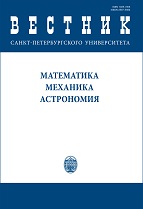|
This article is cited in 1 scientific paper (total in 1 paper)
MECHANICS
Zero velocity surface in the general three-body-problem
V. B. Titov
St Petersburg State University, 7-9, Universitetskaya nab., St Petersburg, 199034, Russian Federation
Abstract:
The zero-velocity surfaces of the general planar three-body problem are constructed in the form space, the factor-space of the configuration space by transfer and rotation. Such a space is the space of congruent triangles, and the sphere in this space is similar triangles. The integral of energy in the form space gives the equation of the zero velocity surface. These surfaces can also be obtained based on the Sundman inequality. Such surfaces separate areas of possible movement from areas where movement is impossible. Without loss of generality, we can assume that the constant energy is $-1/2$ and the sought for surfaces depend only on the magnitude of the angular momentum of the problem, $J$. Depending on this value, five topologically different types of surfaces can be distinguished. For small $J$, the surface consists of two separate surfaces, internal and external ones, the motion is possible only between them. With $J$ increasing the inner surface increases, the outer surface decreases, the surfaces first have a common point at some value of $J$, with a further increasing of $J$, their topological type changes and finally the zero-velocity surface splits into three disjoint surfaces, the motion is possible only inside them. Examples of the corresponding surfaces are given for each of these types, their sections in the plane $xy$ and in the plane $xz$ and the surfaces themselves are constructed, their properties are studied.
Keywords:
general three-body-problem, zero velocity surface, region of feasibility.
Received: 31.05.2022
Revised: 20.06.2022
Accepted: 08.09.2022
Citation:
V. B. Titov, “Zero velocity surface in the general three-body-problem”, Vestnik of Saint Petersburg University. Mathematics. Mechanics. Astronomy, 10:1 (2023), 165–175; Vestn. St. Petersbg. Univ., Math., 56:1 (2023), 125–133
Linking options:
https://www.mathnet.ru/eng/vspua229 https://www.mathnet.ru/eng/vspua/v10/i1/p165
|

| Statistics & downloads: |
| Abstract page: | 28 | | Full-text PDF : | 4 | | References: | 6 |
|




 Contact us:
Contact us: Terms of Use
Terms of Use
 Registration to the website
Registration to the website Logotypes
Logotypes








 Citation in format
Citation in format 
